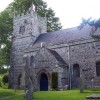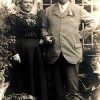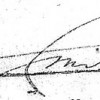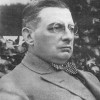The ancestry of John Calcraft of Rempstone Hall, like that of many other Dorset families, did not have its roots in the county with which they are most associated, but in another. Calcraft was born on 14th August 1726 in Grantham, Lincolnshire, son of another John Calcraft who was a lawyer, and a woman called Christian Bursbie. At least, that is the genealogy according to the penned inscriptions in three family Bibles.
But official records tell a rather different story. It is now more likely that John Calcraft was an illegitimate son of the famous Whig parliamentarian Sir Henry Fox by Christian, who also appears to have been the mother of John’s Brother Thomas. For it has been noted that the name Christian occurs more than once in both of these Lincolnshire families; added to that there is a marked resemblance between John and Henry Fox that can be seen in portraits handing at Rempstone Hall in Purbeck.
There are no surviving records about the younger John’s education, but by the age of 18 he had meteorically risen to the position of Deputy Paymaster to the army in Scotland. At 19 he had been entrusted with considerable responsibilities. This entailed commanding and escorting consignments of money from Newcastle to Edinburgh – in winter, often through deep snow. Furthermore, Calcraft was appointed Clerk of the War Office towards the end of 1746, and was to effectively act as Fox’s private secretary. By 1749 the latter was securing army agencies for him and for several years was even recommending him as “a dear relative.”
In March 1753 Fox promoted Calcraft to Deputy Commissary General at 23 shilling a day. One of Calcraft’s friends was General Edward Braddock, who the British had charged with expelling the French from the American colonies in 1754. Braddock however, was killed in action in Quebec soon after, but not before he had made a will in favour of John Calcraft, leaving his table silverware to him. Calcraft was also well acquainted with many of the military leaders of his day, including the Duke of Cumberland and General Wolfe.
Another friend was a cavalry hero, John, Marquis of Granby, who in collaboration with Fox and Calcraft is known to have shared as mistresses two leading stage actresses of the day, Georgina Bellamy and Elizabeth Bride. By 1753 Calcraft had moved in with Georgiana in London, and was amassing a fortune in his work as banker and contractor to the forces. Besides his residence in Parliament Street he acquired a property on Sackville Street and also Ingress Abbey. His relationship with Georgiana seemed to be founded on a lasting basis for several years, but was eventually fated to end when Calcraft was distracted by an attraction to Elizabeth Bride, leaving Georgiana in distress and saddled with many debts. Georgiana had kept house for John from about 1752 to 1761. Calcraft then lived with Elizabeth from 1764 until his death.
Calcraft’s children by Elizabeth were Katherine, born at Parliament Street in 1764; Granby at Ingress Abbey in 1766; Richard at Sackville Street, 1770 and William at Ingress Abbey in 1771. His heir was John, born at Ingress on 16th October 1765, though it is not certain that Elizabeth was his mother. However, since all five children were left to her guardianship after their father’s death, it is thought that John, too, must have been Elizabeth’s son. From his will Elizabeth inherited from Calcraft £3000 and an annuity of £1000 for life.
In 1757 Calcraft acquired the sprawling eleven square mile estate and manor of Rempstone in Purbeck and the manor of Wareham ten years later from Thomas Erle Drax; the same year he bought from John and George Pitt and John Bankes all the remaining Wareham land.
In 1763 Fox, who had gained a reputation for affluence and corruption, was deserted in his cause by Calcraft, in favour of an alliance with William Pitt, 1st Earl of Chatham. Calcraft stood as MP for Calne, Wiltshire from 1766-68, and for Rochester from 1768 to 1772. He also had his younger brother Thomas elected for Poole in 1762 and 1768. Ideologically, he stood for liberty of the people and for Parliamentary reform but only one speech of John has been recorded: during a debate on the Liberty of the Press Bill on December 2nd 1770. In the hope of persuading voters to return the men he favoured to Parliament, Calcraft used his great wealth to buy up boroughs and other property such as Ingress Abbey.
Not long before he died, Calcraft had been the subject of several satirical cartoons and malicious attacks mainly instigated by Fox and Georgiana Bellamy. He was further lampooned by his detractors under the derisory label of “Crafterio.” It is recorded that in appearance Calcraft was a rather tall man with a ruddy complexion, handsome, of easy address and facility of speech that recommended him to others.
John Calcraft died on August 23rd 1772 at the age of only 46. He had not lived long enough to warrant the title of Earl of Osmonde.



